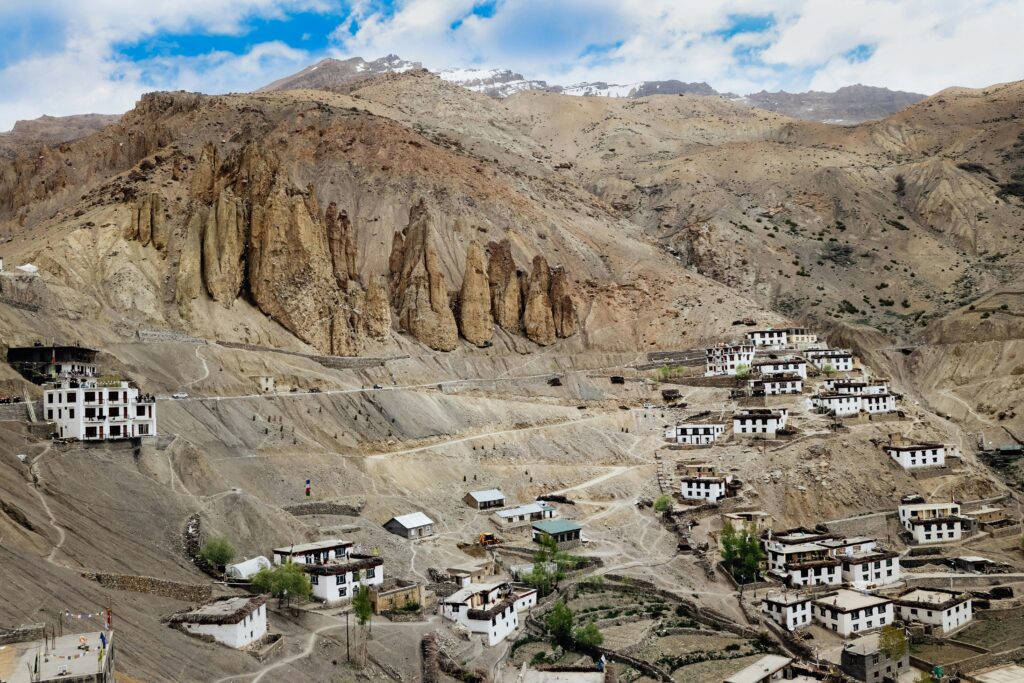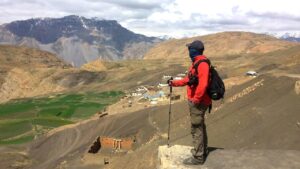” Exploring the Mystical Beauty of Spiti Valley:
Nestled in the northern region of India, between the Tibet Autonomous Region and the Indian state of Himachal Pradesh, lies the enchanting Spiti Valley. Often referred to as “Little Tibet,” Spiti is a high-altitude desert mountain valley renowned for its breathtaking landscapes, ancient monasteries, and unique culture. This hidden gem offers a rare glimpse into a world that is both remote and incredibly vibrant, making it a must-visit destination for adventurous travelers. In this guide, we’ll delve into the myriad attractions of Spiti Valley, practical travel tips, and the essence of what makes this destination so mesmerizing.
A Journey Through the Landscape

Spiti Valley’s landscape is a striking blend of stark, arid terrain and dramatic mountain ranges. The valley is characterized by its rugged mountains, barren hills, and deep blue rivers that cut through the desert-like landscape. The terrain might seem harsh at first glance, but it’s this very ruggedness that creates an otherworldly beauty.
**Key Attractions:**
1. Kaza:

The administrative center of Spiti, Kaza is a small town that serves as a base for exploring the region. Its narrow streets and traditional architecture offer a quaint charm, while its proximity to several monasteries makes it a strategic starting point for your adventure.
2. Key Monastery:

Perched on a hilltop, Key Monastery is one of the most significant Tibetan Buddhist monasteries in the region. Its striking white walls and golden roof against the backdrop of the Himalayas create a mesmerizing sight. The monastery houses a vast collection of ancient manuscripts and artifacts, and its serene atmosphere provides a perfect setting for meditation.
3. Hikkim:

This small village is home to the world’s highest post office, situated at an altitude of 14,567 feet (4,440 meters). Sending a postcard from Hikkim is a unique experience that provides a tangible connection to the remote beauty of Spiti.
4. Langza:

Known for its fossil-rich grounds, Langza offers a fascinating glimpse into the prehistoric past of the region. The village is also famous for its giant Buddha statue, which overlooks the valley and adds a spiritual touch to the landscape.
5. Chandratal Lake:

This high-altitude lake, also known as the “Moon Lake,” is renowned for its crescent shape and shimmering blue waters. Surrounded by snow-capped peaks, Chandratal is a paradise for nature lovers and trekkers.
**Experiencing the Culture**
Spiti Valley is a melting pot of Tibetan culture and Buddhist traditions. The local population predominantly consists of Buddhists, and their way of life is deeply intertwined with the spiritual practices and cultural heritage of the region.
**Cultural Highlights:**
1. Festivals:

The valley is home to several vibrant festivals, including the Losar (Tibetan New Year) and the Chham dance festival, which are celebrated with traditional dances, music, and rituals. These festivals offer a fantastic opportunity to immerse yourself in the local culture.
2. Local Cuisine:

Spiti’s cuisine is hearty and flavorful, often featuring ingredients that are grown locally. Don’t miss out on trying dishes like thukpa (noodle soup), momos (dumplings), and chhaang (a traditional alcoholic beverage made from barley).
3. Monasteries:

In addition to Key Monastery, Spiti Valley is dotted with several other monasteries, such as Tabo Monastery and Dhankar Monastery. These monasteries not only serve as spiritual centers but also as repositories of ancient art and architecture.
**Adventure and Activities**
For adventure enthusiasts, Spiti Valley offers a range of thrilling activities that cater to different interests.
1. Trekking:

The valley is a paradise for trekkers, with trails that vary from easy walks to challenging hikes. The Pin Parvati Pass and the trek to Chandratal Lake are popular routes that offer stunning views of the surrounding landscapes.
2. Mountain Biking:

The rugged terrain and remote roads of Spiti provide an exhilarating experience for mountain biking. The journey through high-altitude passes and unpaved roads is both challenging and rewarding.
3. Photography:

The unique landscapes, vibrant monasteries, and colorful festivals make Spiti a photographer’s dream. The interplay of light and shadow in the desert-like environment creates dramatic and captivating shots.
**Travel Tips and Practical Information**
1. Best Time to Visit: The ideal time to visit Spiti Valley is from late May to early October when the weather is relatively mild and the roads are open. Winter months can be extremely harsh, with heavy snowfall making travel difficult.
2. Getting There: Spiti is accessible by road from Manali and Shimla. The journey from Manali, via the Rohtang Pass, is particularly scenic but can be challenging due to the high altitude. There are also options for hiring local taxis or joining organized tours.
3. Accommodations: Spiti offers a range of accommodations, from basic guesthouses to more comfortable hotels. Staying in a homestay or a monastery guesthouse can provide a more authentic experience.
4. Health and Safety: Due to the high altitude, it’s essential to acclimatize properly to avoid altitude sickness. Carrying medication for altitude sickness and staying hydrated is crucial. Additionally, the remote nature of the region means that medical facilities may be limited, so carry any necessary medications with you.
5. Permits: While Indian tourists typically do not require special permits, foreign nationals need to obtain an Inner Line Permit (ILP) to visit Spiti Valley. This can be arranged through the local authorities or travel agencies.
**Conclusion**
Spiti Valley is a destination that captivates with its stark beauty, rich culture, and adventurous opportunities. It’s a place where nature and spirituality intertwine, offering a serene escape from the hustle and bustle of modern life. Whether you’re seeking adventure, cultural enrichment, or simply a breathtaking landscape, Spiti Valley promises an unforgettable experience that will linger long after your journey ends.
Himachal Tourism Officail,